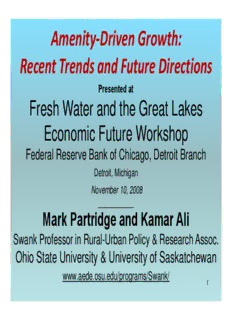
Amenity-driven Growth PDF
Preview Amenity-driven Growth
Amenity‐Driven Growth: Recent Trends and Future Directions Presented at Fresh Water and the Great Lakes Economic Future Workshop Federal Reserve Bank of Chicago, Detroit Branch Detroit, Michigan November 10, 2008 ___________ Mark Partridge and Kamar Ali Swank Professor in Rural-Urban Policy & Research Assoc. Ohio State University & University of Saskatchewan www.aede.osu.edu/programs/Swank/ 1 Outline: Why are we here? 1. Amenity Growth—basic conceptual ideas. – Define amenities • Man-made • Natural 2. Basic evidence of amenities and local economies – Amenities are capitalized into wages and housing prices – They affect population/job growth. 3. Future trends in Amenity-Led Growth 2 1990/91-2006 North American Population Growth 333 Amenities—Conceptual Issues Brief for those who are not familiar with the issue • What are amenities? • Natural amenities: climate, water, landscape, mountains, clean environment. My focus today. • Man-made amenities: • Facilitate natural amenities such as boat ramps or ski resorts (Deller et. al. 2001; Kim et al. 2005) • Urban amenities such as cultural venues, recreation, urban milieu. (Glaeser et al., 2001; Adamson et al., 2004; Florida, 2004) 4 Conceptual Issues • Motivating question is ‘Jobs vs People’ led growth. • Partridge and Rickman J. of Urban Econ. (2003) • Roughly, just under 50% jobs and just over 50% people. Amenities are important! • The basic research on amenities dates to Graves and Linneman (1979) and Roback (1982). • Amenities are normal goods→ rising incomes over time are increasing demand for amenities. • Amenities are capitalized into higher housing costs and lower wages as people crowd into high-amenity areas • Amenities also lead to faster population growth 5 Basic Empirical Evidence • Capitalized into wages and housing costs – Gabriel et al. (2003, p. 632) found the range of quality of life effect, (1989$) or about double for 2008: Variable Max– 1989$ Min—1989$ Heating Degree Days (5,091) 0 -$15,716 Cooling Degree Days (1,215) 0 -$7,358 Wind Speed (9.36 mph) -$1,450 -$2,992 Coast (1=state on coast) $0 $5 Inland Water (2.7% of land) $52 $3,228 Violent Crime (475 per 100k) $19 $499 Air Quality (0.12 pts per mil) -$812 -$7,456 6 Basic Empirical Evidence—cont. • Gabriel & Rosenthal (2004, p.440) RESTAT – For 37 metro areas, examine Quality of Life and Business Environment. Find an inverse association. City QOL Rank QOL $ (2002$) Q of Bus Env QBE $ (2002$) Rank Miami 1 7,990 34 -4,644 San Jose 14 -603 1 13,187 Detroit 37 -8,589 9 3,645 Tampa-St. 5 3,802 37 -7,044 Petersburg Cleveland 31 -2,796 21 90 Chicago 19 1,448 8 3,997 7 Columbus 24 -1,789 26 -1,595 Basic Empirical Evidence—cont. • Schmidt and Courant (2006, p. 939, 942) note that people would take a 4% pay cut to live 100 miles nearer to a ‘nice place’ such as a national park, seashore, landmark. – Omaha is farthest from nice place and Oxnard- Ventura CA is almost the closest. Their results suggest Omaha has 20% higher wages to compensate for this disadvantage (cet. par.). 8 Population and Amenities • Rappaport (2007) finds climate may be most important amenity beginning even in the 1920s (before AC and central heating), suggesting income effect. • McGranahan (1999, 2007) finds huge population growth effects for amenities in rural America. – Climate, topography, landscape, water area – McGranahan (2007, p. 234) finds: • If typical rural Iowa county was 50% forest, 25% cropland vs actual 5% forest, 75% cropland, it would had 7% more net- migration in the 1990s vs 1% on avg. (cet. par.) • If it had 7% water area (like Sawyer County WI) vs actual 2% water area, it would have had 1% more net in- migration. 9 Population and Amenities • Deller et al. (2001) finds that developed recreational facilities, including for water and winter recreation are associated with both faster rural population and rural job growth. • A key point of Deller et al. and Kim et al. (2005) is that natural amenities are necessary, but not sufficient for growth. A location needs developed facilities to really experience growth. • Evidence suggests smaller amenity effects in other countries (for Canada, see Ferguson et al., 2007 and for W. Europe, see Cheshire and Magrini, 2006). 10
Description: